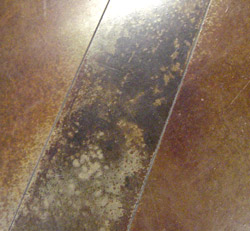|
August 3, 2004
In This Issue of The Acid Staining Newsletter
A Cure for Curing Compound
Today I feel as if I were announcing a cure for cancer. For years I have been telling clients that if their concrete finisher sprayed liquid curing compound on their slab, then acid staining is simply not possible. This is the one big "no-no" that all acid stain manufacturers warn against.
Liquid curing compounds are oily substances which concrete placement workers often spray across the surface of a newly troweled slab in order to slow down water evaporation from the surface. It helps to prevent the formation of many small cracks in hot, dry conditions. There are other ways to slow evaporation, but they are tedious and expensive in labor costs. The slab surface can be misted repeatedly with water or covered with brown curing paper.
If your client suspects that his slab might be tainted by the dreaded CC, there is a simple way he can test for it. Fill a mop with water and swab it across several square feet of the concrete. If the water immediately soaks in and turns the slab a darker shade of gray, you are in luck. Your acid stain will penetrate the floor in a similar manner. However, if the water reveals a spray pattern of light concrete spots scattered across a darker background, you are probably dealing with curing compound.
Liquid curing compound is usually sprayed on with pump-up garden sprayers and coverage is never totally uniform, as it would be as if the floor simply had a sealer rolled onto it. The light spots look waxy and repel water completely. They also resist scrubbing with Trisodium Phosphate solution, concrete floor cleaning products, and acid-water dilutions.
Some manufacturers of curing compounds say that their products will dissipate completely after three months' exposure to ultraviolet light. This may be why we have never run across this problem on outdoor patio jobs. The problem for interior floor stainers is that most builders install roofing long before the slab has been exposed to three months' worth of intense sunlight. In that case, you will have to remove the compound or turn down the job.
Several years ago we tried a curing compound remover made by a large stain manufacturer. It seemed to lift the compound and clump it in new areas, while making us feel nauseated for days. Perhaps we were not wearing the proper kind of mask, but the job was on a screened-in porch, so the toxicity of the product was impressive. We later discovered that xylene scrubbed into the compound spots can remove them, but this is an extreme fire and health hazard. My crew refuses to work with xylene on any scale grander than a few square inches. For some reason they prefer to donate their liver functions to wine drinking instead of floor stripping.
My friend Chris Mirabal, who stains acres of concrete, and has helped me to teach several seminars, has discovered that Sealtight Ultrite Degreaser and Stripper, sold by the W.R. Meadows Company, www.wrmeadows.com will remove curing compounds and make the slab ready for staining. Their phone number is 847-214-2100 in the USA.
 Here is a photo of a 7,000 square-foot bookstore which Chris Mirabal stained, after removing curing compound from the entire slab.
Here is a photo of a 7,000 square-foot bookstore which Chris Mirabal stained, after removing curing compound from the entire slab.
|
Ultrite is biodegradable and gives off a strong pine-cleaner odor.
The company's data sheet says that it "safely replaces mineral spirits and chlorinated solvent type heavy-duty concrete degreaser products... It penetrates concrete surfaces on contact to soften, lift, and remove a wide range of oils, polymers, fats and greases. Use Ultrite Degreaser to remove dirt, tire marks, oil spills, grease and other contaminants. It will also remove most curing compounds and cure/seals from concrete floors."
Needless to say, it should not be used on painted floors unless you want to damage the paint.
|
The product is applied full strength from the container and allowed some time to work, but you must not let it dry out. It is then scrubbed mechanically and the residue rinsed off with large amounts of water. The cleaner is biodegradable, but the petroleum products you are removing may be toxic and should be carefully disposed of.
Chris has used Ultrite to successfully remove curing compound from two floors. We have used it to clean a 30 year old garage floor in preparation for an epoxy finish. One of my workers felt sickened by the piney smell, but the other worker was not bothered by it. Removing curing compound will be an extra hassle and you should definitely charge more for it, but at least you will no longer have to refuse large and tempting jobs.
Happy Staining!
GG
|
|
|


